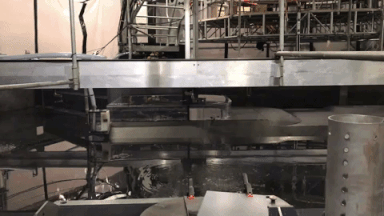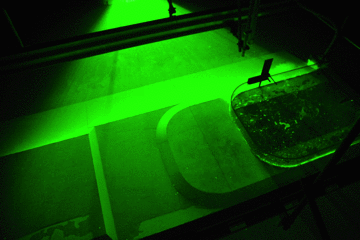I just realized we never showed you that you can see the Coriolis deflection on the inflowing water when we started filling the tank! So here you go. Isn’t that cool? (Remember, we are in the Southern Hemisphere…)



I just realized we never showed you that you can see the Coriolis deflection on the inflowing water when we started filling the tank! So here you go. Isn’t that cool? (Remember, we are in the Southern Hemisphere…)


Written by Anna Wåhlin
—
Anna is a Professor of Physical Oceanography at the Department of Marine Sciences, University of Gothenburg. Her research focus is in the field of Polar Oceanography, mostly in the Southern Ocean. Specifically her research investigates several aspects of dynamics of polar seas including physical oceanography, ocean circulation, topographic effects, ice shelf melt processes and air-sea-ice interaction. When Wåhlin was appointed professor in 2015, she became Sweden’s first female full Professor of Oceanography.
Wåhlin was between 2015-2017 co-chair of the joint Scientific Committee on Antarctic Research (SCAR) and SCOR initiative Southern Ocean Observing System (SOOS). She is an Associate Editor of the journal, Advances in Polar Science and member of IOW scientific advisory board (2016-2019).
Wåhlin’s awards include being a Fulbright Scholar (2007-2008), receiving a Crafoord Research Stipend from the Swedish Royal Academy of Science (2010) and being a SCAR visiting professor (2013).

Don’t you just love watching this kind of stuff? 🙂


What happens when the almost neutrally buoyant particles that we use to visualize the flow field have sunken out of the surface layer?

The fairy-dust sprinkler comes and sprinkles more fairy dust! 🙂

And that produces all these cute little swirls that glow bright green. So pretty! 🙂


We’ve talked before how we use the laser to light up neutrally-buoyant particles on horizontal slices of our tank, but we can actually also do this in the vertical.

This is sometimes very helpful to check whether the particle distribution is still good enough or whether someone needs to go in and stir up some particles before the next experiment.


You’ve probably been wondering about this, too: We have a constant inflow from our “source” into the tank. How do we keep the water level stable?

Worry no more — here is the answer. In the picture above you see Samuel adjusting the skimmer — a sink inside the tank that height is adjusted such that its upper edge is exactly at where the water level should be. So any excess water is skimmed off and drained.
Sounds easy, but it’s actually not — we have a free surface in the tank and we are rotating quite fast, so there is a height difference of almost 10 cm between the center and the outer edge. So a little bit of fiddling around involved…

Written by Céline Heuzé
—
Hi reader! My name is Céline Heuzé (pronounced sort of ‘ozé’), and although I am French this is my first time in Grenoble. I come from Dieppe, on the beautiful Normandy coastline, with high chalk cliffs, very large tides, and powerful crashing waves during the strong winter storms… I guess that’s why I ended up as an oceanographer. I did my PhD in the UK at the University of East Anglia, and moved to Gothenburg in southwest Sweden two years ago to work with Anna Wåhlin.
I actually don’t study Antarctica. Well, I did during my PhD, but then I got more interested into the Arctic and have been looking more and more at it these last years. The reason why I am in Grenoble today is that in fact, it does not matter which region you look at; the same physics laws apply to both the Arctic and Antarctic. You just need to remember that you are in different hemisphere and whack a minus sign here and there. So I am using Elin’s and Anna’s experiments to understand the circulation under a Greenland floating glacier that I measured in 2015: Petermann Glacier, famous for its large calving events in 2010 and 2012. And also because I can act as a French-Swedish-English translator to Anna, while enjoying some nice food and weather!

I read a blog post by Clemens Spensberger over at a scisnack.com couple of years ago, where he talks about how ice can flow like ketchup. The argument that he makes is that ketchup on your hotdog behaves in many ways similarly to glaciers on for example Greenland: If there is a layer of a certain thickness, it will start sliding off — both the ketchup off your hotdog and the glaciers off Greenland. After most of it has dripped to your shirt or in the ocean, a little bit still remains on the hotdog or the mountain. And so on.
What he is talking about, basically, are effects of viscosity. Water, for example, would behave very differently than ketchup or ice, if you imagine it poured on your hotdog or raining down on Greenland. But also ketchup would behave very differently from ice, if it was put on Greenland in the same quantities as the existing glaciers on Greenland, instead of on a hotdog as a model version of Greenland in a relatively small quantity. And if you used real ice to model the behaviour of Greenland glaciers on a desk, then you would quickly find out that the ice just slides off on a layer of melt water and behaves nothing like you imagined (ask me how I know…).
This shows that it is important to think about what role viscosity plays when you set up a model. And not only when you are thinking about ice — also effects of surface tension in water become very important if your model is small enough, whereas they are negligible for large scale flows in the ocean.
The effects of viscosity can be estimated using the Reynolds number Re. Re compares the effects of the velocity u of the flow, a length scale of an obstacle L, and the viscosity v: Re = uL/v.
Reynolds numbers can be used to separate different flow regimes: laminar flows for very low Reynolds numbers, nice vortex streets for Re > 90, and then flows with a stagnant backwater for high Reynold numbers.

I have thought long and hard about what I could give as a good example for what I am talking about here, since all seems so academic. And then I remembered that I did an experiment on vortex streets on a plate a while back.
If you start watching the movie below at min 1:28 (although watching before won’t hurt, either) you see me pulling a paint brush across the plate at different speeds. The slow ones don’t create vortex streets, instead they show a more laminar behaviour (as they should, according to theory).
Vortex streets, like the one shown in the picture above, also exist in nature. However, scales are a lot larger there: See for example the picture below (Credit: Bob Cahalan, NASA GSFC, via Wikipedia)
While this is a very distinctive flow that exists at a specific range of Reynolds numbers, you see flows of all different kinds of Reynold numbers in the real world, too, and not only on my plate. Below, for example, the Reynolds number is higher and the flow downstream of the obstacle distinctly more turbulent than in a vortex street. It’s a little difficult to compare it to the drawing of streamlines above, though, because the standing waves disguise the flow.

One way to manipulate the Reynolds number to achieve similarity between the real world and a model is to manipulate the viscosity. However that is not an easy task: if you wanted to scale down an ocean basin into a normal-sized tank, you would need fluids to replace the water that don’t even exist in nature in liquid form at reasonable temperatures.
All the more reason to use a large tank! 🙂

Just so you don’t get bored over the weekend (and because they are so so beautiful to look at!) here are a couple more sneak peek gifs of our experiments. (For some reason I don’t understand, they take a little while before they start moving. Don’t give up, it’ll happen!)

Remember, though, that what we see are only particle distributions in one layer close to the surface, and also the very beginning of the experiments before the flow has reached a balance. So please don’t over-interpret 🙂


If you are still sitting at your desk right now, we think it’s great that you are procrastinating by reading our blog. And there is definitely some cool stuff on here! But today there is actually a pretty good alternative: It’s the European Researchers’ Night!
Find events near you here. “Discover science, meet researchers, and enjoy yourself!” 🙂